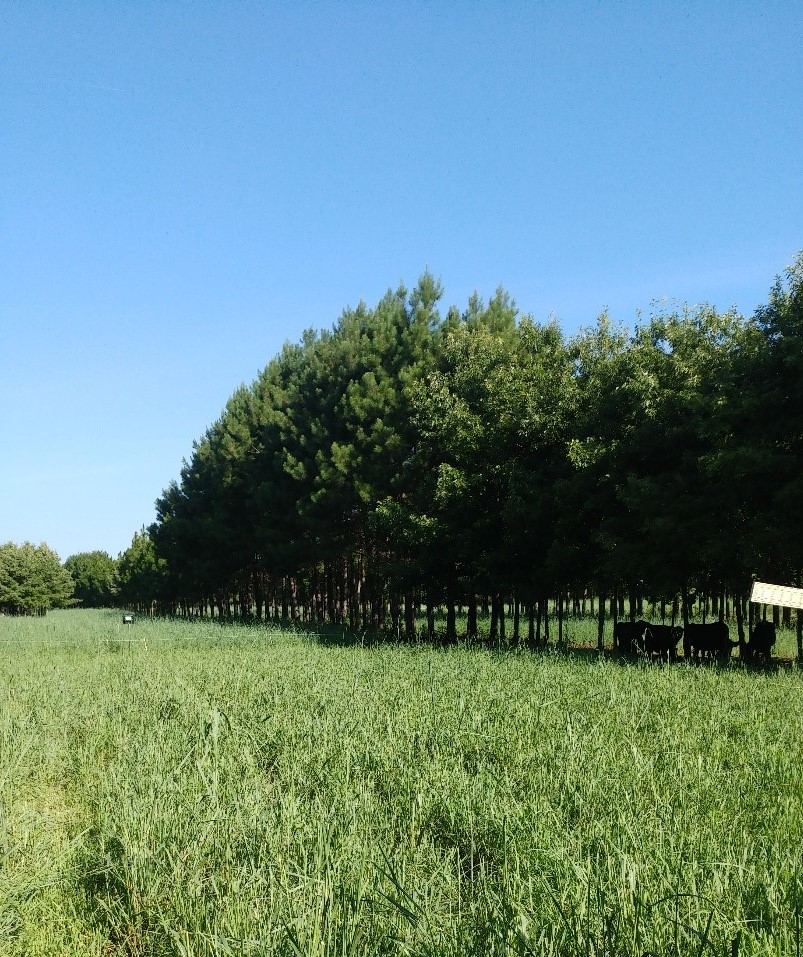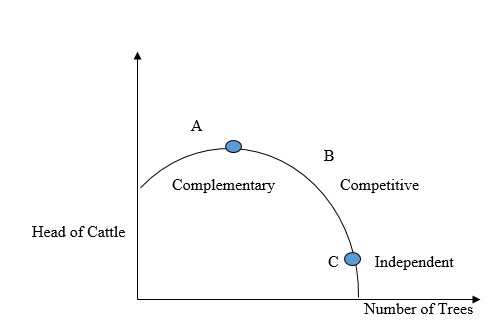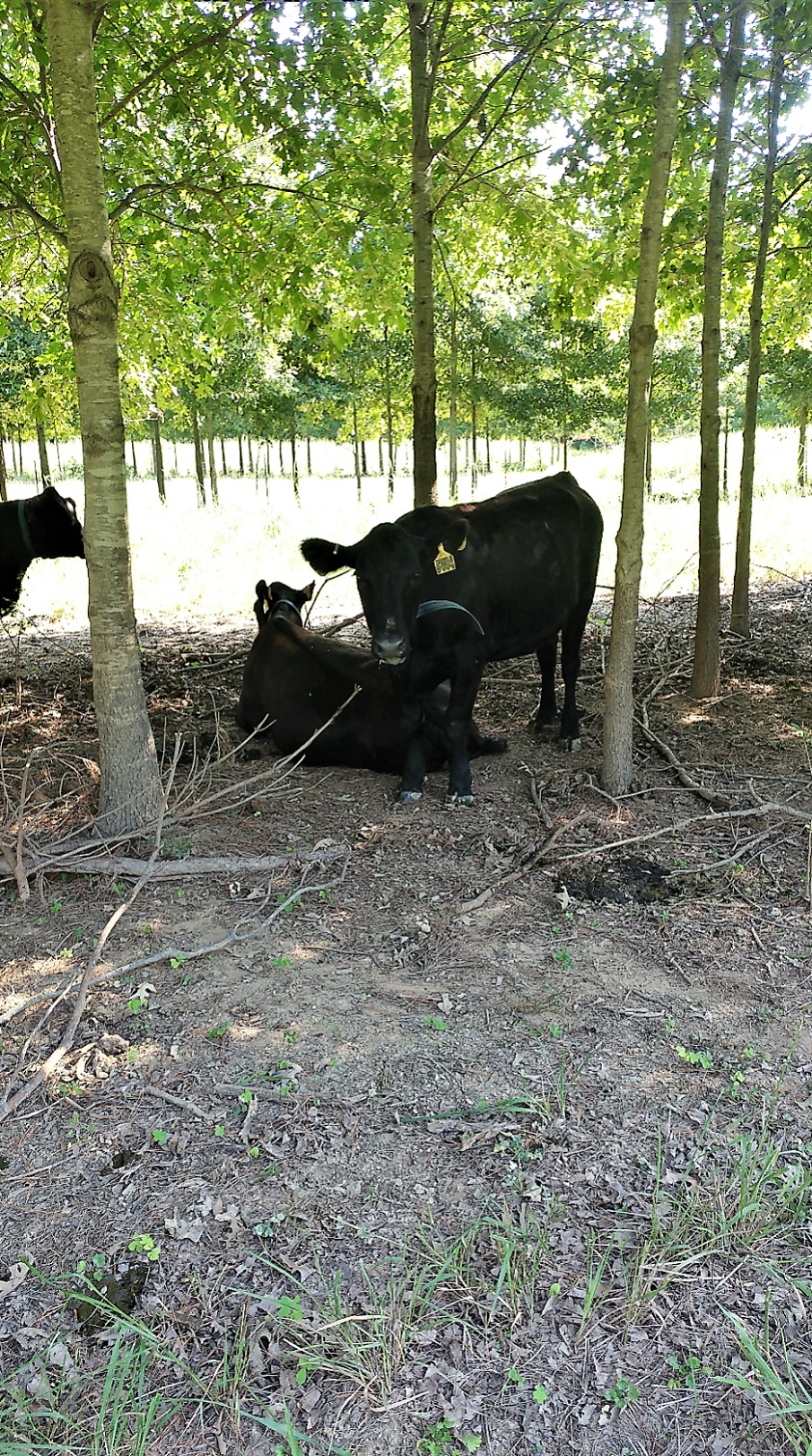Silvopasture, a strategic and managed agroecosystem, integrates livestock, forage, and trees or shrubs to improve individual components (Orefice and Carroll 2017; USDA National Agroforestry Center [NAC] 2012). Chizmar (2018) calculated potential returns to silvopastoral systems with Angus cattle and loblolly pine (Pinus taeda). Data were drawn from a field trial in the Coastal Plain of North Carolina (Figure 1) under various assumptions about the relationships between system components.
 Figure 1. Photo of Angus silvopasture in Wayne County, North Carolina.
Figure 1. Photo of Angus silvopasture in Wayne County, North Carolina.
Complementary, competitive, and independent relationships are modeled as 110%, 75%, and 100% of forage-cattle production, percentages chosen to represent potential land use combinations, when trees are added to a conventional cattle pasture system at a planting density of 435 trees per acre (final density of 65-87 trees per acre after thinning at ages 12 and 18). These relationships are illustrated by the hypothetical Production Possibilities Frontier (PPF) for cattle and trees in Figure 2. Conceptually, the theoretical PPF presents the trade-offs involved in different combinations of cattle and tree stocking rates.
 Figure 2. Production Possibility Frontier for cattle and trees
Figure 2. Production Possibility Frontier for cattle and trees
The complementary region—the segment of the curve from the vertical axis to Point A—is where timber and forage for livestock production benefit one another mutually, such as increased cattle pregnancy success from improved microclimatic conditions. Silvopasture practitioners strive to design operations so system components interact positively to reduce inputs and enhance outputs, which may be technically difficult and site and market specific (Orefice and Carroll 2017; USDA NAC 2012; Chizmar 2018). The competitive region, B, depicts relationships between the two outputs, with more of either trees (in particular, as they overshadow grasses) or forage, reducing the amount of the other output. Possible combinations of cattle and trees in the independent region, Point C to the horizontal axis, are characterized by a range of cattle stocking rates where farmers may increase the head of cattle at the same constant tree density.
The net returns of land use models may be estimated by calculating their Land Expectation Value (LEV), a capital budgeting criterion that calculates the present value of economic returns of indefinite identical treatments and rotations. In the North Carolina case, we used 4%, 8%, and 12% discount rates to calculate LEV. If the components of the silvopastoral system are competitive (region B of the PPF), then it generates lower returns than conventional cattle grazing regimes (SPS Competitive: 4% = $1,268.89 per acre; Conventional cattle-forage: 4% = $1,537.69 per acre). If the components are independent (between the x-axis and point C), the silvopasture system offers higher returns at low discount rates (4% = $1,653.31 per acre). With complementary components (between the y-axis and point A), silvopastures offer the highest returns at all discount rates (4% = $1,807.08 per acre).
These results highlight the importance of designing silvopasture systems in which livestock, forage, and trees interact positively to increase yields and diversify production (Orefice and Carroll 2017; USDA NAC 2012; Chizmar 2018). Pent and Fike (2017, 2018) suggest there is a complementary relationship between trees in a silvopasture system and both the health and weight gain of the livestock in the system, even if there is less available forage under the trees. This may be because silvopastures provide favorable microenvironments for cattle, offering shade and shelter (Figure 3), thus increasing weight gain and reducing calving difficulty (Karki and Goodman 2015; Walthall et al. 2012; Orefice and Carroll 2017). When cattle seek shade and shelter under trees, they also consume understory vegetation, limiting forage competition with the trees.
 Figure 3. Photo of Angus cattle gathering under trees in a research silvopasture.
Figure 3. Photo of Angus cattle gathering under trees in a research silvopasture.
While the analysis in Chizmar (2018) was based on varying assumptions about the effect of trees on the productivity of cattle, clearly it is also important to understand how silvopasture affects the health and vigor of ruminants. After accounting for effects on animal health and ecosystem services (such as carbon sequestration), silvopasture may appear even more economically viable. In addition, Chizmar (2018) considers tree density but does not account for tree distribution, which is indeed another feature to consider when designing silvopastures and may affect overall response patterns. Ultimately, silvopasture systems offer considerable promise as an economically and environmentally beneficial land use system, but further research and extension regarding the merits of silvopastures are required to validate and disseminate these opportunities to farmers.
References:
Chizmar SJ (2018) A comparative economic assessment of silvopasture systems in the Amazonas Region of Peru and in North Carolina, USA. North Carolina State University http://www.lib.ncsu.edu/resolver/1840.20/35059
Karki U, Goodman MS (2015) Microclimatic differences between mature loblolly-pine silvopasture and open-pasture. Agrofor Syst 89. Retrieved from https://search-proquest-com.prox.lib.ncsu.edu/docview/1662573238/fulltextPDF/4E8977D4653A449CPQ/1?accountid=12725
Orefice JN, Carroll J (2017) Silvopasture – It’s not a load of manure: Differentiating between silvopasture and wooded livestock paddocks in the Northeastern United States. J of Forest 115(1):71-71. Retrieved from http://search.proquest.com.prox.lib.ncsu.edu/docview/1863558982?pq-origsite=summon&accountid=12725
Pent GJ, Fike JH (2018) Lamb productivity on stockpiled fescue in honeylocust and black walnut silvopastures. Agrofor Syst. DOI: https://doi.org/10.1007/s10457-018-0264-0
Pent GJ, Fike JH (June 2017) Winter Stockpiled Forages, Honeylocust Pods, and Lamb Performance in Hardwood Silvopastures & Sheep Performance and Behavior in Silvopasture Systems. Agroforestry for a vibrant future: Connecting people, creating livelihoods, sustaining places 15th NAAC on the campus of Virginia Tech in Blacksburg, Virginia USA. Concurrent sessions 5 & 6, room 300
USDA NAC (2012) Silvopasture: An agroforestry practice [PowerPoint slides]. Retrieved from https://nac.unl.edu/practices/silvopasture.htm
Walthall CL, Hatfield J, Backlund P, et al (2012) Climate Change and Agriculture in the United States: Effects and Adaptation. USDA Technical Bulletin 1935. Washington, DC. 186 pages

